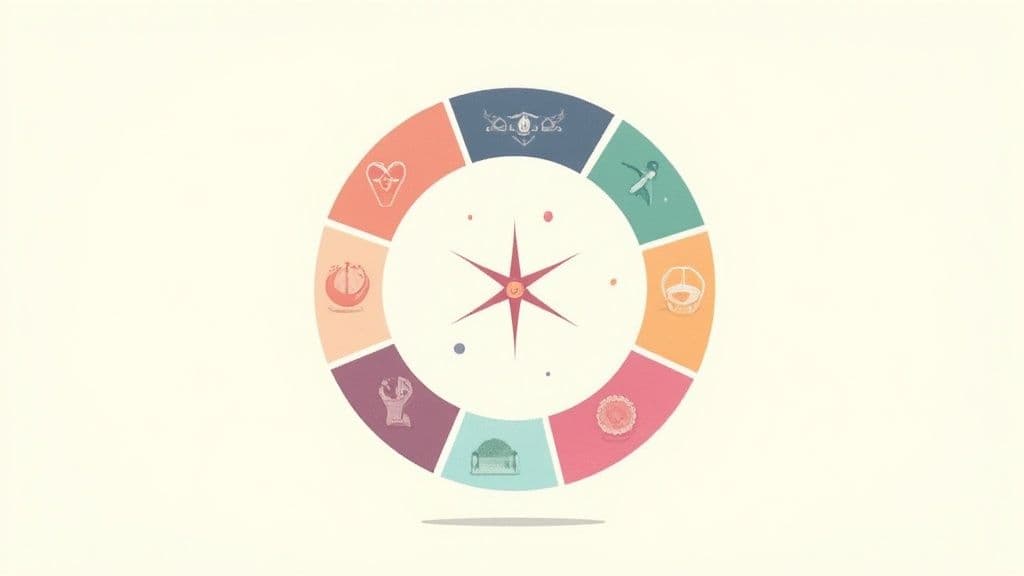It’s easy to fixate on a single big goal—a promotion, savings target, or fitness milestone—and let other parts of life fall behind. Lasting fulfillment comes from tending to the whole landscape of your life. This guide outlines eight essential areas for goal setting, offers practical steps, and shows how Dan Millman’s Life Purpose system can help you align goals with your core strengths and purpose.
October 16, 2025 (1mo ago) — last updated November 11, 2025 (8d ago)
8 Life Areas for Balanced Goal Setting (2025)
Discover eight life areas for balanced goal setting and get practical steps to build a fulfilling, aligned 2025.
← Back to blog
8 Life Areas for Balanced Goal Setting (2025)
Summary: Discover the eight essential life areas for balanced goal setting and get actionable, aligned steps to build a fulfilling 2025.
Introduction
It’s easy to fixate on one big goal—a promotion, a savings target, or a fitness milestone—and neglect the rest of your life. That single-focus approach often leaves people feeling empty after they achieve the goal. Lasting fulfillment comes from tending to the whole landscape of your life. This guide outlines eight key areas for goal setting and offers practical, aligned steps. We also connect these ideas to Dan Millman’s system in The Life You Were Born to Live and the Life Purpose App to help you personalize priorities and stay balanced5.
1. Career & Professional Development
Your professional life is a major part of identity and a primary vehicle for growth and financial stability. This area includes job satisfaction, skill acquisition, long-term trajectory, and entrepreneurial ambitions. Set goals that align with your values and strengths.

Examples of deliberate career planning show the impact of focused goals. Consider Sara Blakely launching Spanx while working full time, or intentional skill development leading to leadership roles.
Actionable Tips for Career Growth
- Define timelines: short-term (6 months) and long-term (3–5 years).
- Document wins: keep a running list of accomplishments for reviews and confidence.
- Seek expert guidance: use career coaching or mentorship when needed. See our internal guide on career planning.
- Build your brand: update LinkedIn, publish insights, and network with purpose.
2. Financial & Wealth Management
Financial health powers many other goals. This domain covers earning, budgeting, saving, investing, and debt elimination. Clear financial goals create security and freedom.

Strategic financial planning can change life trajectories. Whether you follow FIRE principles or structured debt-paydown plans, specific targets drive progress.
Actionable Tips for Financial Growth
- Create a values-based budget (for example, try the 50/30/20 rule).
- Automate savings and investments to “pay yourself first.”
- Set specific, dated goals like “save $10,000 for a down payment by December 2025.”
- Track net worth quarterly to measure real progress.
3. Health & Physical Fitness
Physical health fuels energy, focus, and longevity. This area includes nutrition, exercise, sleep, and preventive care. Consistent habits here support everything else.

Globally, a significant share of adults do not meet recommended activity levels, which affects long-term health1. Prioritizing small, sustainable habits produces the biggest gains.
Actionable Tips for Health & Fitness
- Schedule workouts like meetings and protect that time.
- Use SMART goals: specific, measurable, achievable, relevant, dated.
- Prioritize sleep—most adults should aim for 7–9 hours each night2.
- Find an accountability partner or community for consistency.
4. Relationships & Family
Relationships form the emotional core of life. This area includes romantic partners, family, children, and close friends. Intentional goals here build connection, support, and belonging.

Decades of research show that strong relationships are primary predictors of long-term happiness and health3. Small, regular investments in relationships compound over time.
Actionable Tips for Nurturing Connections
- Schedule quality time: weekly date nights or monthly one-on-ones.
- Practice active listening: give full attention and seek to understand.
- Express gratitude often and specifically.
- Address conflicts promptly and respectfully.
5. Personal Development & Learning
Personal development is the lifelong commitment to growth. It includes formal education, new skills, and emotional maturity. Investing in learning improves adaptability and opportunity.
Actionable Tips for Personal Growth
- Schedule learning blocks (e.g., 30 minutes daily).
- Set concrete goals like completing a course by a specific date.
- Apply knowledge immediately through projects or teaching.
- Use a personal development plan template to track progress. See our learning resources.
6. Mental & Emotional Well-being
Mental and emotional health underpin success across all areas. This includes resilience, emotional regulation, and proactive self-care. Globally, mental health concerns affect a notable share of people, emphasizing the need for ongoing care6.
Actionable Tips for Mental Wellness
- Establish a short daily mindfulness practice.
- Journal to process emotions and spot patterns.
- Seek professional support proactively when needed.
- Practice self-compassion and challenge harsh self-talk.
7. Recreation, Hobbies & Fun
Play and leisure recharge creativity and prevent burnout. Hobbies pursued for enjoyment—not productivity—help sustain long-term performance and joy.
Actionable Tips for Cultivating Fun
- Schedule playtime as you would work commitments.
- Create an experience list for skills and places to explore.
- Try new interests to discover what brings sustained joy.
- Focus on enjoyment rather than mastery.
8. Contribution & Legacy
Contribution brings purpose beyond personal success. This area covers volunteering, mentorship, philanthropy, and stewardship. Small, consistent acts create meaningful ripple effects.
Actionable Tips for Making an Impact
- Align contributions with your skills and passions.
- Start small and be consistent—regular volunteer hours or a set giving percentage.
- Research organizations for effectiveness before committing.
- Involve family and friends to amplify impact.
Goal Setting Areas Comparison Guide
| Area | Implementation Complexity | Resource Requirements | Expected Outcomes | Ideal Use Cases | Key Advantages |
|---|---|---|---|---|---|
| Career & Professional Development | Medium to high | Time, learning, networking | Promotions, fulfillment | Career growth, transitions | Clear metrics, financial impact |
| Financial & Wealth Management | Medium | Time, capital, education | Security, wealth | Budgeting, retirement | Quantifiable targets, compound growth |
| Health & Physical Fitness | Medium | Time, possible costs | Longevity, energy | Preventive health | Measurable results, better productivity |
| Relationships & Family | Medium | Time, emotional energy | Support, happiness | Family, partnerships | Emotional resilience, belonging |
| Personal Development & Learning | Medium | Time, courses | Skills, adaptability | Lifelong learning | Career and personal gains |
| Mental & Emotional Well-being | Medium to high | Time, possible therapy | Resilience, reduced stress | Stress management | Improves relationships and productivity |
| Recreation, Hobbies & Fun | Low to medium | Varies by hobby | Joy, creativity | Work-life balance | Prevents burnout, fosters creativity |
| Contribution & Legacy | Medium to high | Time, money, skills | Purpose, social impact | Volunteering, philanthropy | Deep meaning, community benefit |
Bringing It All Together for a Life in Balance
These eight areas—Career, Finance, Health, Relationships, Personal Development, Mental Well-being, Recreation, and Contribution—work together. The goal isn’t perfection. It’s awareness and intentional adjustment. Use your priorities as a compass and make conscious choices about where to focus in each season.
Start by selecting one or two areas that need attention and set a single, meaningful goal. Use tools like the Life Purpose App to uncover your life path and align goals with your core strengths and purpose5. For planning templates and exercises, see our goal-setting toolkit.
FAQs
Q: How do I choose which area to focus on first? A: Assess current satisfaction in each area, pick one or two with the biggest gap between importance and reality, and set a single SMART goal to start.
Q: What if I don’t have time for all eight areas? A: Prioritize by season. Use small, consistent actions in lower-priority areas so nothing falls apart while you focus on the most urgent goals.
Q: How can I track progress across multiple life areas? A: Use a quarterly review with simple metrics (hours invested, milestones hit, mood ratings). Track net worth for finance, sleep and activity for health, and qualitative notes for relationships and meaning.
Ready to align your goals with your life path? Discover personalized insights with the Life Purpose App at https://lifepurposeapp.com.5
Discover Your Life Purpose Today!
Unlock your true potential and find your life’s purpose.
